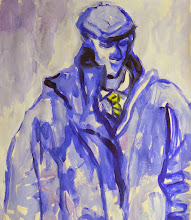Just to surprise us with a bit of magic, the planet
Uranus stands on end with his rings in a unique axis of rotation - tilted vertically with North and South poles where other planets have their equators. Neat trick!:
Uranus the Planet
Photo taken by the Hubble Space Telescope.
Uranus is the seventh planet from our sun. An ice giant it has 27 natural satelites, with the five largest named:
Miranda, Ariel, Umbrial, Titania, and Oberon from works by Shakespeare and Poe.
In mythology
Uranus is named after the Greek deity of the Sky,
Ouranos, or Father Sky. He is the father of
Cronus (Saturn) and grandfather of
Zeus (Jupiter) and is personified as the son
and husband of
Gaia, Mother Earth.
The concept for this painting was therefore not too difficult - my
Uranus would be presented as a modern day magician, and the very first one that sprung to mind was
David Nixon whom I used to watch and love on TV as a boy:
David Nixon
Naughty boy that I am, I considered somehow to have the planet disc represented by Nixon's bald head! But no that would be too disrespectful.
Next magician to come to mind was another great favourite, mainly because all his tricks usually went wrong,
Tommy Cooper:
Tommy Cooper
"Not like this, like that, ha ha ha!"
I thought I might be able to do something with his fez.
These ideas were really just "
scratchings" - digging around to see what ideas might arise.
But the real starting point for the painting was approached similar to those of my "
Facial Feelings" with colours and shapes I felt would best describe the mysteriousness of a magician on stage:
Design Study 1
Neocolours in sketchpad, A5.
Mostly dark colours - black, midnight blue, purple set off with a few flashes of brilliance - turquoise, orange, pink, referencing the magicians dinner suit and curtains on the stage with high points of intensity - the lights, the moment of revelation.
I like this study very much and will make a painting of it sometime, but this project needs figures to tell the story, and it is in my sketchpads I spend time searching for a suitable manner of combining figures with these colours:
Design Study 2
Neocolours in sketchpad, A4.
Every magician needs a lovely assistant and it is here that I have introduced
Miranda as his helper. But what can she be helping with?:
Design Study 3
Neocolours in sketchpad, A4.
I have her holding up a large disc, also representing the planet, for Uranus to work his magic on.
The idea is beginning to gel so I work it up as a watercolour sketch:
Design Study 4
Watercolours in sketchbook, A4.
Playing around with different elements trying to get something that satisfies.
Beginning to firm up on the design with a final, full-size, design study:
Design Study 5
Neocolours on paper, A2.
Uranus has developed into a suave gentleman in black tuxedo and cape with red lining, a neat bow-tie, long thin moustach and goatee beard, holding a magicians wand in one hand pointing to the planet disc, and a top-hat in the other from which he may later produce a rabbit or some doves!
Miranda wears a short pink dress and her long flowing strawberry-red hair, tied with a bow, cascades down her back. She holds up the disc like a paper-covered hoop or balloon, which, on the words of
abracadabra will burst open to reveal...what? Who knows, but it will be magic!
With the final painting, in oils, I run into some difficulties. The figures are stiff and not to my liking. They are even somewhat cartoonish with Uranus's extended arm:
Final Painting?
Oils on canvas, 61x42cm.
This is as far as I could take it at the time so it was laid aside for a while to contemplate what to do with it.
Still contemplating.
It needs a final going over.
 This is selection was about two-thirds of the total.
This is selection was about two-thirds of the total. From top left they are: "Flying Beauty"; "Ugly Beauty"; "Moth" and "Mustardseed" from my Scherzo Polyptych; "Joy" and "Anxiety" from my Facial Feelings
From top left they are: "Flying Beauty"; "Ugly Beauty"; "Moth" and "Mustardseed" from my Scherzo Polyptych; "Joy" and "Anxiety" from my Facial Feelings From top left they are: "Neptune"; "Artemis"; "Saturn"; "Jupiter"; and bottom row: "Apollo"; "Gaia"; "Venus".
From top left they are: "Neptune"; "Artemis"; "Saturn"; "Jupiter"; and bottom row: "Apollo"; "Gaia"; "Venus". Both packages were delivered by courier on 11 June 2010.
Both packages were delivered by courier on 11 June 2010.


















































